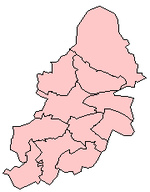Kingstanding
| Kingstanding | |
.jpg) Witton Lakes, a leisure amenity for Erdington and Kingstanding |
|
 Kingstanding |
|
| Population | 25,334 (2011.Ward)[1] |
|---|---|
| – density | 59.0 per ha |
| OS grid reference | SP085945 |
| Metropolitan borough | Birmingham |
| Metropolitan county | West Midlands |
| Region | West Midlands |
| Country | England |
| Sovereign state | United Kingdom |
| Post town | BIRMINGHAM |
| Postcode district | B44 |
| Dialling code | 0121 |
| Police | West Midlands |
| Fire | West Midlands |
| Ambulance | West Midlands |
| EU Parliament | West Midlands |
| UK Parliament | Birmingham Erdington |
|
|
Coordinates: 52°32′53″N 1°52′23″W / 52.548°N 1.873°W
Kingstanding is an area in north Birmingham, England.[2] It gives its name to a ward in the Erdington council constituency.[2] Kingstanding ward includes the areas; Perry Common, St. Mary's College, Witton Lakes and parts of Kingstanding, Wyrley Birch. [2] The other part of Kingstanding falls under the Oscott ward.
Kingstanding houses a covered drinking water reservoir, Perry Barr Reservoir, on the site of the former Perry Barr Farm.
Kingstanding is served by two libraries; Kingstanding Library and Perry Common Library.
History
The name of the area is derived from the occasion when the Stuart King Charles I supposedly reviewed his troops standing on the Neolithic Bowl Barrow in the area on October 18, 1642 during the English Civil War, after his stay at nearby Aston Hall. The first references to Kingstanding were as King's Standing.
The course of the Icknield Street Roman Road runs past this barrow; and when the foundations for the water pumping station were being dug in 1884, a hoard of Roman coins was discovered.[3]

The area was largely rural until the 1928, when large-scale residential development commenced in the area.[3] The first of the estates was completed in 1934.[4] It was during the 1930s and 1940s that most of the current housing was built. Most of the houses in Kingstanding were built as council houses with the majority being located in the north of the area. At the time, it was the largest council housing development in Europe, containing some 6,700 properties on its completion.[5]
In 1935, an Odeon cinema, designed by Cecil Clavering,[6] was opened on Kingstanding Circle.[7] On June 6, 1964, Kingstanding Library opened. It had an area of 1,000 sq ft (93 m2) and was identified as being liable to mining subsidence.[8]
Kingstanding is featured in the novel The Last Viking by Dr Ron Dawson. The author grew up at number 79 Parkeston Crescent, and used the estate and its many characters as the backcloth to his Birmingham-based novel.[9]
Politics
The Kingstanding ward was the scene of political controversy in May 2006 when it initially appeared its voters had elected a British National Party candidate, Sharon Ebanks, to Birmingham City Council - the first BNP candidate ever to be elected in Birmingham. However, it was announced by the Returning Officer shortly after the declaration that a counting error had taken place and, following a High Court recount, Ebanks was removed as Councillor on July 26, 2006 and replaced by Labour candidate Catherine Grundy.[10] The other councillors are Zoe Hopkins and Peter Kane, both of the Labour party. However, since then the BNP have fallen away to such an extent that local Conservative Gary Sambrook, who was only 18 at the time of the election, fell only 80 votes short of defeating Labour in this once safe seat that regularly racked up 4 figure majorities.
Kingstanding has a Ward Support Officer.
World War II
A number of bombs were dropped on the then new Kingstanding housing estate during World War II. On 25 August 1940, four people including a three-year-old boy were killed when a bomb hit a house in Kingstanding Road, while a bomb in Oundle Road claimed the life of a 27-year-old man and a third bomb in Hurlingham Road resulted in the death of a 61-year-old woman.[11]
Population
Kingstanding had a population 25,702 at the time of the 2001 Population Census. It has a population density of 5,410 people per km² compared with 3,649 people per km² for Birmingham. It has a small ethnic minority population with ethnic minorities representing 10.6% (2,724) of the ward's population as opposed to 29.6% for Birmingham. White British is the largest ethnic population living in Kingstanding.
Notable residents
- Lloyd Dyer, professional footballer currently playing for Watford in the Coca Cola Championship, attended Cardinal Wiseman School between 1994-1999
- Dr Ron Dawson. Educationist, researcher and author lived in Parkeston Crescent, attended Twickenham Road School, 1945-1951.[12]
- Kingstanding is the headquarters of the 23 Special Air Service Regiment.[13]
See also
References
- ↑ "Birmingham Ward population 2011". Retrieved 14 December 2015.
- 1 2 3 http://www.birmingham.gov.uk/kingstanding
- 1 2 Raven, Michael (2005). A Guide to Staffordshire and the Black Country, the Potteries and the Peak. Michael Raven. p. 151. ISBN 0-906114-33-0.
- ↑ Helen Elizabeth Meller (1997). Towns, Plans and Society in Modern Britain. Cambridge University Press. ISBN 0-521-57644-X.
- ↑
- ↑ Jane Turner (1996). The Dictionary of Art. Grove. ISBN 1-884446-00-0.
- ↑ Anne Massey (2000). Hollywood Beyond the Screen: Design and Material Culture. Berg Publishers. ISBN 1-85973-321-2.
- ↑ Library Association (1964). The Library Association Record. Library Association.
- ↑ The Last Viking
- ↑ End of the road for BNP seat battle - Birmingham Mail (July 27, 2006)
- ↑
- ↑
- ↑ Hurst, Ben (26 December 2008). "SAS to march through Birmingham to receive freedom of city". Birmingham Mail. Retrieved 5 May 2015.

